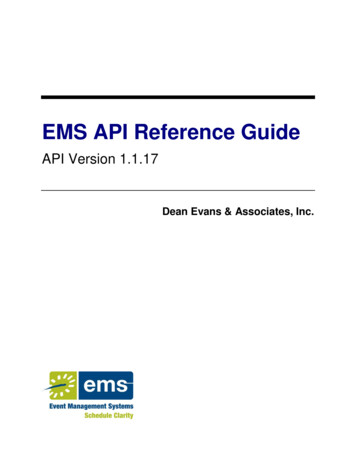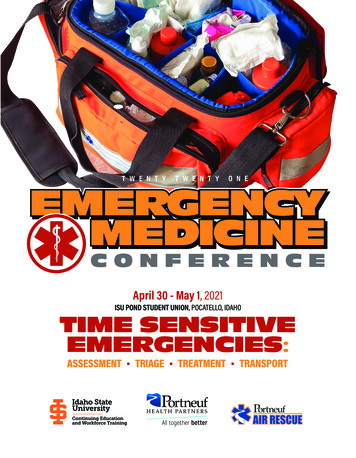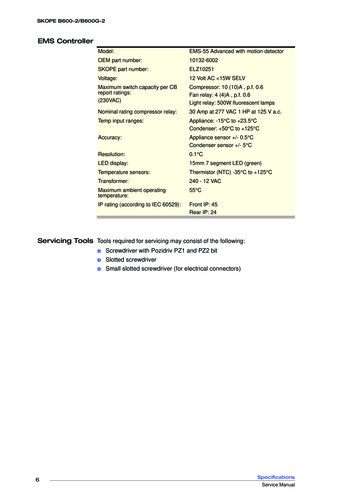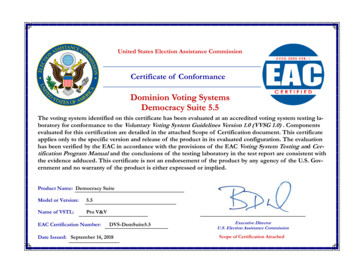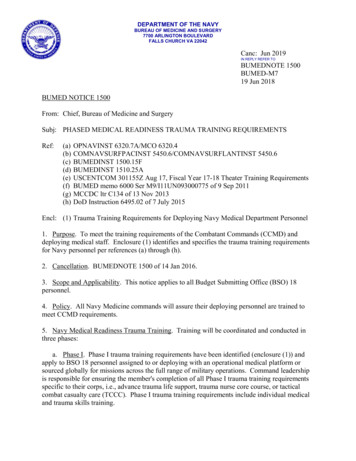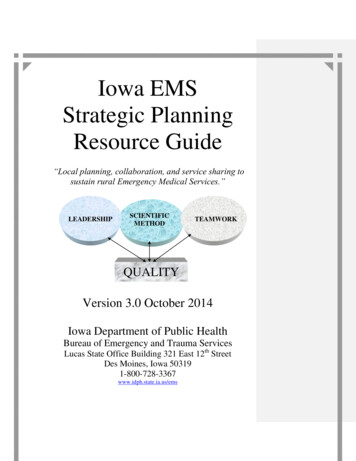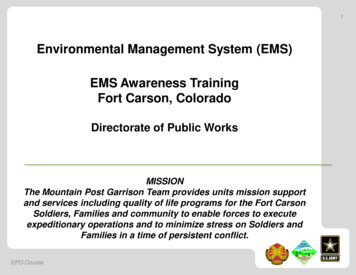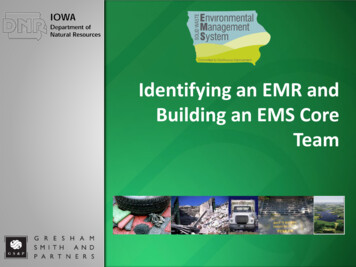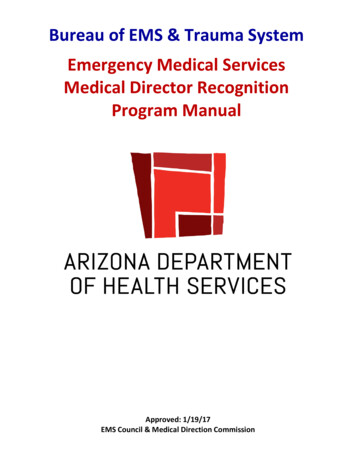
Transcription
Bureau of EMS & Trauma SystemEmergency Medical ServicesMedical Director RecognitionProgram ManualApproved: 1/19/17EMS Council & Medical Direction Commission
TABLE OF CONTENTSIntroductionMDR Program BackgroundMDR Program BenefitsApplication StandardsCriteriaCriteria for RenewalMedical Direction Agreement TemplateContinuous Quality Improvement FormsUseful Website LinksAttachment-1 Citations for Sample Qualifications & Job Description for EMS Medical DirectorAttachment-2 CitationsAttachment-3 Performance Improvement PlanAttachment-4 Application FormReferencesAcknowledgmentsApproved: 1/19/17 EMS Council & Medical Direction Commission1
INTRODUCTIONThe Emergency Medical Services (EMS) Medical Director is an essential component of an EMS and trauma system. TheBureau of Emergency Medical Services and Trauma System (Bureau) Medical Director Program has been developed torecognize physicians who demonstrate the necessary commitment to their unique and essential role as EMS MedicalDirectors within Arizona’s EMS and Trauma System. That commitment extends to: EMS system measurement,EMS system development at the state, regional and local levels,Continuing education, training and maintenance of core competencies,Knowledge of and compliance with regulatory requirements,Bureau verification of medical director commitment to meet or exceed program criteria.Role and Duties of the EMS Medical DirectorThe roles of EMS medical directors can best defined by the degree of engagement and consistency of actions they takefor the systems they oversee. EMS system successes can be commensurate with the level of intensive EMS medicaldirector involvement.1 Physicians who serve EMS agencies or base hospitals in this capacity provide essential clinicalguidance, leadership, and oversight for all aspects of prehospital care. From a patient care perspective, an emergencymedical care technician (EMCT) serves as an extension of the EMS medical director. Fundamentally, the most importantduties of an EMS medical director are to formulate system performance specifications, monitor compliance with thosespecifications, and initiate action for compliance as needed. The EMS medical director MUST be engaged with the designand execution of retrospective, concurrent, and prospective quality improvement (QI) initiatives for an EMS agency orbase hospital to optimize clinical outcomes. These QI initiatives should have clearly defined processes and outcomes,along with assignment of roles for the individuals involved (e.g., QI/QA team, educator, supervisor). It is specificallyrecognized that concurrent quality improvement can be a very efficient and cost-effective way to create and maintainculture, change behavior, and identify important information about patient care activities. This relies on direct oversightof EMS personnel at the time of service delivery. The Bureau strongly recommended that EMS medical directors activelyparticipate in prehospital care by providing on-site medical direction through “ride along” and scene response activities.This should be considered fundamental to the job of EMS medical direction.1 The EMS agency or base hospital shouldprovide the necessary resources, time and personnel to achieve desired results from all QI initiatives.The above recommendations are based on evolving national standards and core competencies of EMS medicine. SeeAttachment-1 for two publications providing specifics to these recommendations.PROGRAM BACKGROUNDThe EMS physician is a vital, but not yet fully integrated or supported component of the Arizona EMS and TraumaSystem. The Bureau established standards for EMS medical directors in rule under Arizona Administrative Code (A.A.C.)§§ R9-25-201 and R9-256-202, facilitating qualification benchmarks. In May 2016, the Bureau solicited volunteers fromthe medical direction community to develop initial training standards, continuing medical education (CME) standardsand performance expectations for an EMS Medical Director Program. This EMS Medical Director Program Manual andApplication is the result of the Medical Director Workgroup’s collective efforts. Precedence for this program includes thePremier EMS Agency Program, the Treat and Refer Recognition Program, Excellence in Prehospital Injury Care (EPIC),and SHARE.PROGRAM BENEFITSThe EMS Medical Director Program is intended to be a natural extension of the American Board of EmergencyMedicine’s 2010 approval of EMS medicine as a unique subspecialty discipline as well as the subsequent creation of theFellow of the Academy of Emergency Medical Services (FAEMS) designation by the National Association of EMSPhysicians. The Medical Director Program will facilitate the following benefits: Increase individual and collective awareness of the EMS medical director’s contribution to high qualityprehospital care, improved patient safety and outcomes, and integration of prehospital care into the overallhealthcare continuum,Approved: 1/19/17 EMS Council & Medical Direction Commission2
Promote consistency in training, qualifications, activities, and performance of physicians serving as EMS medicaldirectors across the state,Establish a mechanism for the Bureau to identify EMS medical directors through a single database in order toenhance communication and collaboration, andEncourage EMS medical directors to become personally involved in EMS Regional Council meetings, and Bureaustatutory and standing committees (i.e., EMS Council, STAB, MDC, Education, TEPI, and PMD).The EMS Medical Director Program will be reviewed annually by the Bureau to ensure that it continues to facilitate andpromote EMS-related physician commitments and the roles of EMS medical directors. The program will be continuouslyevaluated to maintain high levels of integrity, relevance, and quality.APPLICATION STANDARDSI. The application includes the following requirements from Arizona Revised Statutes (A.R.S.) and ArizonaAdministrative Code (A.C.C.) – See Attachment-2 The physician must be licensed pursuant to A.R.S. Title 32, Chapter 13 or 17 and provide direction within theArizona EMS and Trauma System. The physician must meet the Administrative Medical Director (AMD) requirements of A.A.C. § R9-25-201. The AMD must ensure online medical direction is consistent with A.A.C. § R9-25-202.II. Criteria Meet the physician requirements delineated in A.A.C. § R9-25-201, EMS Board Certification or completion of an EMS Medicine Fellowship (optional), Complete at least five hours of EMS continuing medical education (CME) each year, with a total of 20 EMS CMEhours during the four-year EMS Medical Director Period, Maintain core competencies during the four-year EMS Medical Director Period, Demonstrate ongoing commitment to evidence-based medicine, Engage in direct oversight of EMS providers through scene response or ride-along time. Personal involvement in regional EMS councils or Bureau of EMS statutory or standing committees, Completion of an EMS Medical Director’s Course, e.g., NAEMSP, ACEP (course offered during annual meeting),See Attachment-3 for the Performance Improvement Plan.III. Criteria for RenewalThe EMS Medical Director card is valid for four years from the initial application completion date. EMS medical directorsmust re-apply and meet all criteria, including A.A.C. § R9-25-201 requirements, on or before the current expiration date.IV. Medical Direction Agreement Template (Optional)Example medical direction agreement templates: FEMA USFA Medical Directors HandbookV. Continuous Quality Improvement Forms Data & Quality Assurance SectionBurnsCardiac ArrestMajor TraumaST-Segment Elevation Myocardial InfarctionStrokeApproved: 1/19/17 EMS Council & Medical Direction Commission3
VI. Useful Website Links Arizona Prehospital Information & EMS Registry System (AZ-PIERS)Statutory and Regulatory ResourcesTime Sensitive Emergencies ResourcesBureau of EMS & Trauma System Online ServicesStatutory and Standing CommitteesDrug Profiles (Bureau Website)EMS Regional CouncilsCommunity ParamedicineArizona Treat & Refer ProgramNational Association of EMS Physicians (NAEMSP)National Association of State EMS Officials (NASEMSO)National EMS Information System (NEMSIS) Technical Assistance CenterEMS Compass InitiativeVII. CitationsSee Attachment-2 Arizona Revised Statutes and Arizona Administrative Code Citation Language.VIII. Application Form (See Attachment-4)Approved: 1/19/17 EMS Council & Medical Direction Commission4
ATTACHMENT-1SAMPLE QUALIFICATIONS AND JOB DESCRIPTION FOR EMS MEDICAL DIRECTOR“Medical Direction of Emergency Medical Systems.” Medical Oversight of EMS. Pepe, P, Ed. RR Bass, etal. Dobuque: Kendall/Hunt Publishing Company, 2009. 51;“Legal Issues.” Medical Oversight of EMS. Maggiore, WA., Ed. RR Bass, et al. Dobuque: Kendall/HuntPublishing Company, 2009. 90).Approved: 1/19/17 EMS Council & Medical Direction Commission5
ATTACHMENT-2ARIZONA REVISED STATUTES AND ARIZONA ADMINISTRATIVE CODE CITATION LANGUAGEA.R.S. Title 36 – Public Health & SAFETY, Chapter 21.1 Emergency Medical Services§ 36-2201. Definitions1. “Administrative medical direction” means supervision of emergency medical care technicians by a base hospitalmedical director, administrative medical director or basic life support medical director. For the purposes of thisparagraph, “administrative medical director” means a physician who is licensed pursuant to title 32, chapter 13 or 17and who provides direction within the emergency medical services and trauma system.§ 36-2204. Medical Control5. Medical standards for certification and recertification of certified emergency receiving facilities and advanced lifesupport base hospitals and approval of physicians providing medical control or medical direction for any classification ofemergency medical care technicians who are required to be under medical control or medical direction.6. Standards and mechanisms for monitoring and ongoing evaluation of performance levels of all classifications ofemergency medical care technicians, emergency receiving facilities and advanced life support base hospitals andapproval of physicians providing medical control or medical direction for any classification of emergency medical caretechnicians who are required to be under medical control or medical direction.7. Objective criteria and mechanisms for decertification of all classifications of emergency medical care technicians,emergency receiving facilities and advanced life support base hospitals and for disapproval of physicians providingmedical control or medical direction for any classification of emergency care technicians who are required to be undermedical control or medical direction.A.A.C., Article 2. Medical Direction; ALS Base Hospital Certification§ R9-25-201. Administrative Medical DirectionA. An emergency medical services provider or ambulance service shall:1. Except as specified in subsection (B) or (C), designate a physician as administrative medical director who meets one ofthe following:a. Has emergency medicine certification issued by a member board of the American Board of Medical Specialties;b. Has emergency medical services certification issued by the American Board of Emergency Medicine;c. Has completed an emergency medicine residency training program accredited by the Accreditation Council forGraduate Medical Education or approved by the American Osteopathic Association; ord. Is an emergency medicine physician in an emergency department located in Arizona and has current certification in:i. Advanced emergency cardiac life support that includes didactic instruction and a practical skills test, consistent withtraining recognized by the American Heart Association, in:(1) Airway management during respiratory arrest;(2) Recognition of tachycardia, bradycardia, pulseless ventricular tachycardia, ventricular fibrillation, pulseless electricalactivity, and asystole;(3) Pharmacologic, mechanical, and electrical arrhythmia interventions; and(4) Immediate post-cardiac arrest care;ii. Advanced trauma life support recognized by the American College of Surgeons; andApproved: 1/19/17 EMS Council & Medical Direction Commission6
iii. Pediatric advanced life support that includes didactic instruction and a practical skills test, consistent with trainingrecognized by the American Heart Association, in:(1) Pediatric rhythm interpretation;(2) Oral, tracheal, and nasal airway management;(3) Peripheral and central intravenous lines;(4) Intraosseous infusion;(5) Needle thoracostomy; and(6) Pharmacologic, mechanical, and electrical arrhythmia interventions;§ R9-25-202. On-line Medical DirectionA. An emergency medical services provider or ambulance service shall:1. Ensure that a physician provides on-line medical direction to EMCTs on behalf of the emergency medical servicesprovider or ambulance service only if the physician meets one of the following:a. Has emergency medicine certification issued by a member board of the American Board of Medical Specialties;b. Has emergency medical services certification issued by the American Board of Emergency Medicine;c. Has completed an emergency medicine residency training program accredited by the Accreditation Council forGraduate Medical Education or approved by the American Osteopathic Association; ord. Is an emergency medicine physician in an emergency department located in Arizona and has current certification thatmeets the requirements in R9-25-201(A)(1)(d)(i) through (iii)A.R.S. Provisions Related to Liability Immunity & Good Samaritan StatusTitle 36, Chapter 6 Public Health Control, Article 4 Communicable Disease Information§ 36-661. DefinitionsIn this article, unless the context otherwise requires:10. "Good Samaritan" means a person who renders emergency care or assistance in good faith and withoutcompensation at the scene of any accident, fire or other life-threatening emergency and who believes that a significantexposure risk occurred while the person rendered care or assistance.Title 36, Chapter 21.1 Emergency Medical Services, Article 1 General Provisions§ 36-2206. Immunity; Emergency InstructionsA. Any health care provider licensed or certified to practice in this state who in good faith gives emergency instructionsto emergency medical care technicians at the scene of an emergency is not liable for any civil damages as a result ofissuing those instructions.B. Any emergency medical services or health care provider who in good faith provides prearrival instructions followingthe minimum standards established by the state pursuant to section 36-2204, paragraph 9 is not liable for any civildamages as a result of issuing these instructions.Title 36, Chapter 21.1 Emergency Medical Services, Article 3 Automated External Defibrillators§ 36-2263. Civil liability; Limited immunity; Good SamaritanA. The following persons and entities are not subject to civil liability for any personal injury that results from any act oromission that does not amount to wilful misconduct or gross negligence:1. A physician who provides oversight.Approved: 1/19/17 EMS Council & Medical Direction Commission7
ATTACHMENT-3PERFORMANCE IMPROVEMENT PLANPersonal involvement in and documentation of a performance improvement plan (PIP), including data collection andevidence of implementation, for the following disease processes:Acute Stroke:o Patient’s last well known timeo Stroke assessment and resultso Contact date/time hospital was contactedo Blood glucoseo Transport to a Stroke Center (if available)STEMI:o ECG acquisitiono Notification of the receiving hospital on the ECG (results/transmit)o Aspirin administration (unless contraindicated)o Transport to a Cardiac Center (if available)Out-of-Hospital Cardiac Arrest:o Bystander CPR documentationo Whether cardiac arrest was witnessedo Initial cardiac rhythmo Whether return of spontaneous circulationo Termination of resuscitation timeo CPR quality measureso Time to defibrillationo Transport to a Cardiac Center (if available)Major Trauma:o Minimize on scene timeo Trauma triage criteria meto Vital Sign measuremento Document any transfers of patientso Intubations attempts and successeso TBI treatment guidelines followedo Transport to a designated Trauma Center (if available)Rapid Sequence Intubation (RSI)o EMS agencies performance rapid sequence intubation (RSI) requires 100% CQI of RSI patients’ ePCRs.Approved: 1/19/17 EMS Council & Medical Direction Commission8
EMS MEDICAL DIRECTOR PROGRAM APPLICATIONBUREAU OF EMERGENCY MEDICAL SERVICES & TRAUMA SYSTEMEMS MEDICAL DIRECTOR PROGRAM APPLICATIONSECTION I. APPLICANT PHYSICIAN INFORMATION1 Physician Name (Last, First, MI)2 Medical License Number3 Primary Business Address4 Office Phone Number5 Email Address6 Photo of ApplicantPlease attach a close up photo in a JPEG format for the issued card.SECTION II. PRACTICE LOCATIONS (Copy & Paste Additional Rows with text fields if needed)Agency/Entity NameRole/TitleEntity/Agency TypeSECTION III. COMMITTEES & COUNCILS INVOLVEMENTWhich EMS Regional Councils and Statutory/Standing Committees you are personally involved with and your capacity?EMS Regional CouncilsNameCapacityADHS Statutory CommitteesADHS Standing CommitteesNameNameCapacityCapacitySECTION IV. BOARD CERTIFICATIONSPlease indicate your board certification or eligibility for the two boardsAmerican Board ofEmergency MedicineCertifiedEligibleAmerican Osteopathic Boardof Emergency MedicineCertifiedEMS Board CertificationEligibleCertifiedEligiblePlease list other qualifications-related activities and responsibilities9Other/HospitalED Medical Director
SECTION V. ATTESTATIONSCHECKBOXYour initials for each statement signifies your attestation1 Personal involvement in regional councils, ADHS statutory and/or standing committees listed in Section IV.2Board certification or eligibility in the American Board of Emergency Medicine and the American OsteopathicBoard of Emergency Medicine3Complete at least 5 hours of EMS continuing medical education (CME) each year, totaling 20 EMS CME hoursduring the 4-year Period.4 Commitment to evidence-based medicine.5 Maintain core competencies during 4-year periodPersonal involvement in and documentation of a performance improvement plan, with data collection and6 evidence of implementation for Acute Stroke, STEMI, OHCA, Major Trauma, and RSI (please confirm compliancefor each criterion listed below).SECTION VI. RESERVED FOR RENEWAL ONLYPlease Attach in Section VI.A. Below Documentation Consistent with Section IV Attestation StatementsATTACHMENTS FOR SECTION VII.B. RENEWALBy signing below, I attest that I am committed to supporting the tenets and requirements of the EMS Medical DirectorProgram, and will notify the Bureau of EMS and Trauma System if information in this application changes.Physician Printed NameDate:Physician SignatureDate:Please Email Completed Applications To: Dr. David Harden, JD, NREMT hardend@azdhs.govApproved: 1/19/17 EMS Council & Medical Direction Commission10
REFERENCES1. Pepe, P et al. “Medical Direction of Emergency Medical Services Systems.” Medical Oversight of EMS. Ed. RR Bass, etal. Dobuque: Kendall/Hunt Publishing Company, 2009.ACKNOWLEDGEMENTSThe Department of Health Services is grateful to the members of the EMS Medical Director Program Workgroup: Gail Bradley, MD, (Workgroup Co-Chair) Goodyear, Peoria, Sun City Fire Departments EMS Medical Director Franco Castro-Marin, MD, (Workgroup Co-Chair) Scottsdale Fire Department Medical Director Jonathon Maitem. DO, Honor Health Deer Valley Hospital Medical Director Garth Gemar, MD, Glendale Fire Department Medical Director Jason Johnson, MD, Summit Regional Medical Center Medical Director Joshua B. Gaither, MD, Associate EMS Medical Director, Banner University Medical Center – Tucson Toni Gross, MD, Emergency Department Physician, Phoenix Children’s HospitalBureau of EMS &Trauma System Staff: Bentley Bobrow, MD, Medical Director Terry Mullins, MPH, Bureau Chief Ithan Yanofsky, Deputy Bureau Chief David Harden, JD, Strategic Planning & Communications Section ChiefApproved: 1/19/17 EMS Council & Medical Direction Commission11
6 ATTACHMENT-2 ARIZONA REVISED STATUTES AND ARIZONA ADMINISTRATIVE CODE CITATION LANGUAGE A.R.S. Title 36 - Public Health & SAFETY, Chapter 21.1 Emergency Medical Services § 36-2201. Definitions 1. "Administrative medical direction" means supervision of emergency medical care technicians by a base hospital medical director, administrative medical director or basic life support medical .
